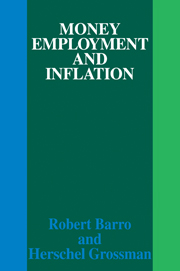Book contents
- Frontmatter
- Contents
- Dedication
- Preface
- Introduction
- 1 The basic model
- 2 Output and employment under non-market-clearing conditions
- 3 Capital, financial assets, and the rate of return
- 4 Inflation and rates of return
- 5 Inflation and unemployment
- 6 The dynamics of aggregate demand
- 7 Output and employment with wage and price speculation
- References
- Index of names
2 - Output and employment under non-market-clearing conditions
Published online by Cambridge University Press: 07 October 2011
- Frontmatter
- Contents
- Dedication
- Preface
- Introduction
- 1 The basic model
- 2 Output and employment under non-market-clearing conditions
- 3 Capital, financial assets, and the rate of return
- 4 Inflation and rates of return
- 5 Inflation and unemployment
- 6 The dynamics of aggregate demand
- 7 Output and employment with wage and price speculation
- References
- Index of names
Summary
This chapter develops a simple framework for analyzing the levels of output and employment when exchange takes place under non-market-clearing conditions. Section 2.1 outlines the essentials of this framework. Section 2.2 considers the case of general excess supply. Section 2.3 considers the case of general excess demand. Section 2.4 considers the general problem of determining the levels of output and employment corresponding to any given levels of wages and prices. Section 2.5 considers the dynamics of wage, price, output, and employment adjustments when exchange takes place under non-market-clearing conditions.
Exchange under non-market-clearing conditions
In chapter 1 we analyzed the determination of the quantities of the economic goods and their exchange ratios within two different contexts. First, we developed a comparative-statics analysis of the relations between the exogenous variables of the model and the values of the endogenous variables which satisfy the market-clearing conditions. Second, we developed a dynamic analysis of the endogenous variables as they moved over time in order to satisfy the market-clearing conditions. This analysis was based on the assumption of recontracting. In this analysis the nominal wage rate and the price of commodities adjusted gradually in response to notional excess supplies and demands in the markets for labor services and commodities. Meanwhile, because of the recontracting privilege, actual transactions remained suspended until the wage rate and price level were consistent with equality between the quantities supplied and demanded in both markets.
- Type
- Chapter
- Information
- Money Employment and Inflation , pp. 38 - 100Publisher: Cambridge University PressPrint publication year: 1976



